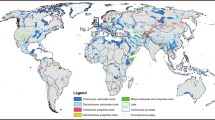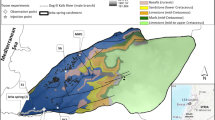Abstract
The combined use of pumping and tracer test data enabled the derivation of equivalent average hydraulic conductivities (K avg) for each test in a heterogeneous channelized alluvial aquifer, whereas K values of the preferential flow paths were two orders of magnitude higher. Greater and earlier drawdown was generally observed along preferential flow lines in a pumping test, within an array of 21 wells. The study aim was to characterize hydraulic properties of a channelized aquifer system in New Zealand by combining tracer and pumping test data. Estimates were able to be made of the percentage of highly permeable channels within the profile (∼1.2%), effective porosity that reflected the maximum fraction of highly permeable channels within the aquifer (ϕ eff –pc ∼0.0038), and flows through highly permeable channels (∼98%) and the sandy gravel matrix material (∼2%). Using ϕ eff –pc, a tracer test K avg value (∼93 m/day) was estimated that was equivalent to pumping test values (∼100 m/day), but two orders of magnitude smaller than K calculated solely from transport through permeable channels (K pc ∼8,400 m/day). Derived K values of permeable and matrix material were similar to values derived from grain size distribution using the Kozeny-Carman equation.
Résumé
L’utilisation combinée de données obtenues par pompage d’essai et par traçage a permis de déduire des conductivités hydrauliques moyennes (K avg) pour chacun des tests dans un aquifère alluvial hétérogène parcouru de chenaux, alors que les valeurs de K des lignes d’écoulement préférentiel étaient plus élevées de deux ordres de grandeur. Un rabattement plus important et antérieur a été observé en général le long de lignes d’écoulement préférentiel lors d’un pompage d’essai, au sein d’un dispositif de 21 puits. Le but de l’étude était de caractériser les propriétés hydrauliques d’un système aquifère parcouru de chenaux, en Nouvelle Zélande, en combinant des donnés de traçage et de pompage d’essai. Des estimations ont pu être faites du pourcentage de chenaux très perméables dans la section (∼1.2%), de la porosité efficace qui reflétait la fraction maximum de chenaux très perméables au sein de l’aquifère (ϕ off–pc ∼0.0038), et des écoulements à travers des chenaux très perméables (∼98%) et du matériau de la matrice de gravier sableux (∼2%). En utilisant ϕ off–pc, une valeur de K avg des tests de traçage (∼93 m/jour) a été estimée qui était équivalente aux valeurs des pompages d’essai (∼100 m/jour), mais deux ordres de grandeur plus petite que K calculé uniquement à partir du transit à travers des chenaux perméables (K pc ∼8.400 m/jour). Des valeurs de K déduites du matériau perméable et de la matrice étaient semblables aux valeurs obtenues à partir de la distribution de la taille des grains en utilisant l’équation de Kozeny-Carman.
Resumen
El uso combinado de ensayos de bombeo y trazadores permitió la estimación de las conductividades hidráulicas promedio (K prom) para cada ensayo en un acuífero heterogéneo canalizado, en tanto que los valores de K de las vías preferenciales de flujo resultaron dos órdenes de magnitud mayores. En una batería de 21 pozos, se observaron descensos mayores y más rápidos en ensayos de bombeo a lo largo de líneas preferenciales de flujo. El propósito del estudio fue la caracterización de las propiedades hidráulicas de un sistema acuífero canalizado en Nueza Zelandia, mediante la combinación de datos de ensayos de bombeo y trazadores. Fue posible estimar el porcentaje de canales de alta permeabilidad en el perfil (∼1.2%), la porosidad efectiva que refleja la fracción máxima de canales de alta permeabilidad en el acuífero (ϕ ef–cp ∼0.0038), y el flujo a través de los canales de alta permeabilidad (∼98%) y la matriz de grava y arena (∼2%). Utilizando ϕ ef–cp, con un ensayo de trazador se estimó la K prom (∼93 m/día) que resultó equivalente a la obtenida lcon ensayos de bombeo (∼100 m/día), aunque dos órdenes de magnitud menor que la K calculada a partir del transporte a través de canales permeables (K cp ∼8,400 m/día). Las estimaciones de la K de la matriz y del material permeable son similares a los valores derivados de la distribución del tamaño de granos usando la ecuación de Kozeny-Carman.










Similar content being viewed by others
References
Anderson MP (1989) Hydrogeologic facies models to delineate large scale trends in glacial and glaciofluvial sediments. Geol Soc Am Bull 101:501–511
Ashworth PJ, Best JL, Peakall J, Lorsong JA (1999) The influence of aggradation rate on braided alluvial architecture: field study and physical scale-modelling of the Ashburton River gravels, Canterbury Plains, New Zealand. In: Smith ND, Rogers J (eds) Fluvial Sedimentology VI, International Association of Sedimentologists Special Publication 28. Blackwell, Oxford, pp 333–346
Boulton NS (1973) The influence of delayed drainage on data from pumping tests in unconfined aquifers. J Hydrol 19:157–169
Carman PC (1937) Fluid flow through granular beds. Trans Instit Chem Eng 15:150–156
Carman PC (1938) Determination of the specific surface of powders. Trans J Soc Chem Indus 57:225–234
Close M, Pang L (1995) Hydrogeological Characteristics of the Burnham Groundwater Contamination Experimental Site. CSC 95/9, Institute of Environmental Science and Research, Christchurch, New Zealand
Close M, Stanton G, Pang L (2002) Use of rhodamine WT with XAD-7 resin for determining groundwater flow paths. Hydrogeol J 10:368–376
Cooper HH, Jacob CE (1946) A generalized graphical method for evaluating formation constants and summarizing well field history. Am Geophys Union Trans 27:526–534
Davey G (2006) A Contribution to the Understanding of Canterbury Plains Aquifers. Environment Canterbury, Report U06/08, Christchurch, New Zealand
Doherty J, Brebber L, Whyte P (1994) PEST model: independent parameter estimation. Watermark, Brisbane, Australia
Feehley CE, Zheng C, Molz FJ (2000) A dual-domain mass transfer approach for modeling solute transport in heterogeneous aquifers: application to the Macrodispersion Experiment (MADE) site. Water Resour Res 36:2501–2515
Fogg GE, Noyes CD, Carle SF (1998) Geologically based model of heterogeneous hydraulic conductivity in an alluvial setting. Hydrogeol J 6:131–143
Hunt B (2007) Groundwater Analysis Using Function.xls. University of Canterbury, New Zealand. http://www.civil.canterbury.ac.nz/staff/hunt/Groundwater%20Analysis%20Using%Function.pdf.nz/staff/hunt/Groundwater%20Analysis%20Using%Function.pdf)
Jussel P, Stauffer F, Dracos T (1994) Transport modeling in heterogeneous aquifers, 1. statistical description and numerical generation of gravel deposits. Water Resour Res 30:1803–1817
Lee J-Y, Lee K-K (1999) Analysis of the quality of parameter estimates from repeated pumping and slug tests in a fractured porous aquifer system in Wonju, Korea. Ground Water 37:1531–1537
Louden AG (1952) The computation of permeability from simple soil tests. Geotechnique 3:165–182
Meier PM, Carrera J, Sanchez-Vila X (1998) An evaluation of Jacob’s method for the interpretation of pumping tests in heterogeneous formations. Water Resour Res 34:1011–1025
Moench AF (1997) Flow to a well of finite diameter in a homogenous, anisotropic water table aquifer. Water Resour Res 33:1397–1407
Moreton DJ, Ashworth PJ, Best JL (2002) The physical scale modelling of braided alluvial architecture and estimation of subsurface permeability. Basin Res 14:265–285
NCCB and RWB (Resource Investigations Division of the North Canterbury Catchment Board and Regional Water Board) (1983) Interim report on the groundwater resource of the central plains. Report, NCCB and RWB, Canterbury, New Zealand
Niemann WL, Rovey CW (2000) Comparison of hydraulic conductivity values obtained from aquifer pumping tests and conservative tracer tests. Ground Water Monit Rem 20:122–128
Pang L, Close ME (1999a) Field-scale physical nonequilibrium transport in an alluvial gravel aquifer. J Contam Hydrol 38:447–464
Pang L, Close ME (1999b) A field study of nonequilibrium and facilitated transport of Cd in an alluvial gravel aquifer. Ground Water 37:785–792
Pang L, Close ME, Noonan M (1998) Rhodamine WT and Bacillus subtilis transport through an alluvial gravel aquifer. Ground Water 36:112–122
Pang L, Close M, Goltz M, Noonan M, Sinton L (2005) Filtration and transport of Bacillus subtilis spores and the F-RNA phage MS2 in a coarse alluvial gravel aquifer: implications in the estimation of setback distances. J Contam Hydrol 77:165–194
Ritzi RW, Jaynes DB, Zahradnik AJ, Field AA, Fogg GE (1994) Geostatistical modeling of heterogeneity in glaciofluvial, buried-valley aquifers. Ground Water 32:666–674
Rovey CW, Niemann WL (2005) Do conservative solutes migrate at average pore-water velocity? Ground Water 43:52–62
Sanchez-Vila X, Meier PM, Carrera J (1999) Pumping tests in heterogeneous aquifers: an analytical study of what can be obtained from their interpretation using Jacob’s method. Water Resour Res 35:943–952
Sinton LW, Noonan M, Finlay RK, Pang L, Close ME (2000) Transport and attenuation of bacteria and bacteriophages in an alluvial gravel aquifer. NZ J Mar Freshw Res 34:175–186
Thorbjarnarson KW, Huntley D, McCarty JJ (1998) Absolute hydraulic conductivity estimates from aquifer pumping and tracer tests in a stratified aquifer. Ground Water 36:87–97
Trahan RS, Phanikumar MS, Hyndman DW, Weissmann GS (2002) Evaluating pumping tests with geologically-constrained models in a heterogeneous alluvial aquifer. Lawrence Livermore National Laboratory, Livermore, CA, AGU National Meeting, 6–10 December, AGU, Washington, DC
Urish DW (1981) Electrical resistivity-hydraulic conductivity relationships in glacial outwash aquifers. Water Resour Res 17:1401–1408
Vandenbohede A, Lebbe L (2003) Combined interpretation of pumping and tracer tests: theoretical considerations and illustration with a field test. J Hydrol 277:134–149
Webb EK, Anderson MP (1996) Simulation of preferential flow in three-dimensional, heterogeneous conductivity fields with realistic internal architecture. Water Resour Res 32:533–545
Weissmann GS, Fogg GE (1999) Multi-scale alluvial fan heterogeneity modeled with transition probability geostatistics in a sequence stratigraphic framework. J Hydrol 226:48–65
Weissmann GS, Trahan RS, Phanikumar MS, Hyndman DW (2004) What do pumping tests mean? Evaluation of a heterogeneous alluvial aquifer. Lawrence Livermore National Laboratory, Livermore, CA, GSA National Meeting, Denver, CO, 7–10 November 2004
Wu C-M, Yeh T-CJ, Zhu J, Lee TH, Hsu N-S, Chen C-H, Sancho AF (2005) Traditional analysis of aquifer tests: comparing apples to oranges. Water Resour Res 41:1–12
Yeh GT (1981) AT123D: analytical transient one-, two-, and three-dimensional simulation of waste transport in the aquifer system. ORNL-5602. Environmental Sciences Division Publication no. 1439. Oak Ridge National Laboratory, Oak Ridge, TN, 88 pp
Acknowledgements
The authors would like to thank Environment Canterbury (ECAN) for financing the Burnham well installation and also assisting with the running and interpretation of the pump test. In addition we would like to thank Grant Davey (formerly of ECAN) for his geological insights, photos and suggestions. The authors would also like to thank Tom Cochrane from the University of Canterbury for valuable comments and suggestions and also an anonymous reviewer whose comments and suggestions greatly improved the manuscript.
Author information
Authors and Affiliations
Corresponding author
Rights and permissions
About this article
Cite this article
Dann, R.L., Close, M.E., Pang, L. et al. Complementary use of tracer and pumping tests to characterize a heterogeneous channelized aquifer system in New Zealand. Hydrogeol J 16, 1177–1191 (2008). https://doi.org/10.1007/s10040-008-0291-4
Received:
Accepted:
Published:
Issue Date:
DOI: https://doi.org/10.1007/s10040-008-0291-4




